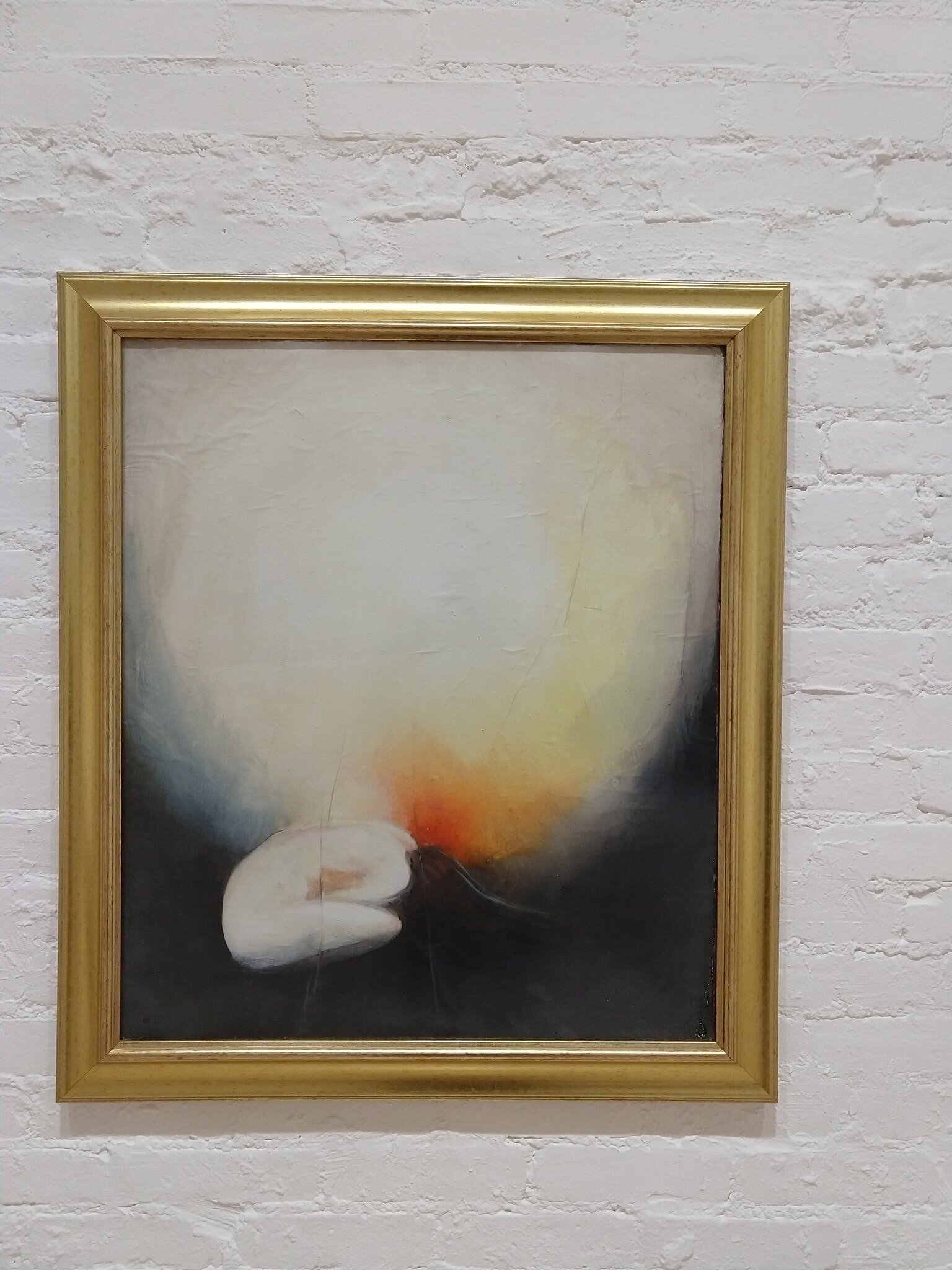21: Unfinished Piece
An unfinished piece, two types of silence, an unfinished peace.
The original tweet can be found here.
Welcome to Accession.
I normally score episodes of Accession with beautiful music, usually by the folks at Blue Dot Sessions or from my friends. I really feel like the music helps the emotion of a piece resonate, and helps me make you feel like art makes me feel. But if that's the purpose, then this essay must be backed by silence. I look at this painting, and feel this kind of hollow, echoing silence.
Normally I would tell you how to get to a piece of art, the twists and turns of a museum and what you’d see along the way. This time I don't know how. I’ve only seen this painting online. It's in Brooklyn, in the Museum of Modern Art PS1 Gallery, at their Theater of Operations: The Gulf Wars 1991-2011 show that's going on for just a few more weeks. But I first saw this painting on Twitter a couple of weeks ago, along with the photos of the two plaques on the walls beside it. I think I retweeted it then, but this weekend I've felt an ache that told me I needed to write these lines, and speak about this painting again, and put it on this feed where it cannot get lost in the atemporality of the timeline.
The image is currently the show art for the podcast, so if you look at your podcast app right now, the image you see should be the image I saw on Twitter that day. If you can't look at it right now, it's worth me taking a minute to describe it, but if you can look at it, I'd urge you to do so. It hangs on a brick wall, in a simple, modest, golden frame. The bottom third of the canvas is a darkness, a darkness that creeps up the edges and acts like a cup. And at the bottom of that cup kneels a woman. She might be praying, or she might be holding her stomach in pain. We can’t really see her face. Her dark hair blends in seamlessly with the darkness below. The edge of her white linen dress is the only truly hard line in the painting. And above her, in the rest of the cup, a bright, blinding, unforgiving light-- a light that starts with a perfectly white center, and spreads to a pearl and a cream, before turning the tips of the darkness to blues. In the world of this painting, it seems like nothing could stop this spreading light. Nothing, that is, except the brush of red that emanated from her head, that pushes out against the light, turning orange, and then gold, and then cutting a streak of yellow through the light. Its striking. With silence, this painting sings its pain, the failure of dualism, and isolation in a binary world.
The card next to it reads "Layla Al-Attar, Iraqi, 1944-1993, Unfinished Painting, 1993, Oil on Canvas. Private Collection." I will admit, I'm often very fond of unfinished paintings. Sometimes I think the story they tell can be more profound than what the artist intended it to be originally. I like to imagine that the image I see is something better than what the artist could have come up with if they had finished it, and somehow I'm getting a view into something truer than true, greater than great. I bet I thought that when I got here the first time. I think I probably flipped back to the painting and wondered what could possibly be left to do with such a powerful image. My privilege gave me a moment to not put all those pieces together yet. But I'm sure some of you have already figured it out.
The last card reads as follows:
"Born in Baghdad, Layla Al-Attar was one of the first female graduates of its Institute of Fine Arts, going on to become a well-known painter and the director of the Iraqi National Art Museum. Often depicting nude figures with primordial landscapes, her surreal works harken back to origin stories such as The Epic of Gilgamesh and the Garden of Eden. Painted in 1993, this unfinished work is among the very last she undertook. Before being able to complete it, she was killed at home in a missile attack ordered by President Bill Clinton."
This is where that hollow, echoing silence comes in. We could go back and recontextualize the light and the dark and the red and the woman, but I'll leave that for you.
There is another tweet that has brought me into silence in the past few days. But not a hollow silence; a silence full of anger, an anger built on fear; a silence that is suffocating, and isolating, and makes me feel powerless. On January 4th, 2020, the 45th President, in reference to the assassination of Major General Qasem Soleimani said on Twitter, "Let this serve as a WARNING that if Iran strikes any Americans, or American assets, we have targeted 52 Iranian sites (representing the 52 American hostages taken by Iran many years ago), some at a very high level & important to Iran & the Iranian culture, and those targets, and Iran itself, WILL BE HIT VERY FAST AND VERY HARD. The USA wants no more threats!"
I want to make something abundantly clear. By both the Hauge and Geneva conventions, the destruction of cultural sites is a war crime. It is an atrocity. It shows no strength, and only a baseless lack of humanity. And as a lover of art, a student of history, and a human being, I absolutely cannot read that tweet and let my silence linger. This man must be stopped. These crimes, these threats, this warmongering, hate spewing demagoguery must be condemned. War will happen. I don't like it, and I can't change it. But there is a thread that connects this painting, and Layla Al-Attar, and Bill Clinton, and the tweet that was sent on January 4th by Donald Trump. These men do not care about freedom, or general welfare, or common defense, or humanity, or any of the things that the Founders of this country stood for. They care about their power, and the legitimazation of that power by destroying both the culture of the past and the creators of the future. This is not power, it is cowardice. This is not strength, it is weakness. This is not greatness, this is failure; failure of the American Experiment, failure of the Christian Experiment, and failure of the Human Experiment.
So if you love art, like I do, if you love humanity, like I do, if you have ever dared to say you follow some version of the Golden rule, then please help me fill this silence. Write letters to your Congressmen, write letters to your neighbors, talk to those who agree with you and those who do not. I told you this episode is not like any other and it has no happy ending. No hope punk twist. At least not today. Not as I write this on January 7th, 2020. As I write this today, we have work to do, in every and any way that we can, in every and any way that you can, in every and any way that I can. Whatever it is that you can and need to do to end this silence, I'm here by your side. We are not alone. Layla Al-Attar never finished this piece. We might not finish our peace either. But we'll paint. We'll paint because we can. We'll paint because we need to. We'll paint because we are human beings, and because love will win some day. And if our painting is left unfinished, so be it. All the better. Our peace will be truer than true, and greater than great.




